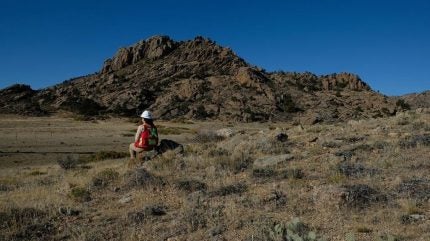
Rare earth elements (REEs) have become an increasing focus of the mining industry as their demand grows as part of the increasing drive for new tech and electrification. However, trying to obtain these elements can be tricky and finding new sources is essential.
ARR has recently been developing a massive new mining project in Halleck Creek, Wyoming, that could shake up the rare earths market and bring large-scale domestic REE production to the US once again.
Here, Joe Evers, general counsel at ARR, sheds light on the company’s ground-breaking discovery at Halleck Creek, its potential impact on the rare earths market, and the pivotal role it could play in reshaping both Wyoming’s economy and the US rare earths industry.

Kit Million Ross: What is your role at ARR?
Joe Evers: In my current role in the organisation, I help set the company’s legal, land management and regulatory strategies. Having grown up in Sheridan, Wyoming, I believe that Wyoming is one of the best states in the country in which to bring on a new REE mine.
I am a product of the state’s public education system, which is funded predominately from royalties and taxes generated from mineral development and the extraction industry. In fact, portions of ARR’s Halleck Creek prospect are State of Wyoming mineral leases that could eventually help fund the state’s school districts.

US Tariffs are shifting - will you react or anticipate?
Don’t let policy changes catch you off guard. Stay proactive with real-time data and expert analysis.
By GlobalDataKnowing that the minerals industry is a primary source of education funding is important to me since my mother is a retired Wyoming school teacher. I attended the University of Wyoming, where I received my bachelor’s, master’s and law degrees. I have worked in the energy sector since I began my career.
KMR: What is the history of this recent discovery at Halleck Creek?
JE: REE prospecting in this area has been ongoing for some time. In the mid-1990s, talented geologists at the University of Wyoming kicked things off through their academic research, which led to the discovery of REEs in the area. Before that, south-eastern Wyoming saw prospecting for copper, iron, uranium and other minerals.
ARR’s history in the area started around 2020 when the company acquired its initial interests, which have been expanded upon. Since that time, ARR’s team of geologists based in Laramie, Wyoming, have undertaken multiple sampling and exploration drilling campaigns to map the resource at Halleck Creek. That drilling has yielded valuable core and chip samples to help advance the metallurgy for processing Halleck Creek’s REEs.
KMR: How significant could this be for the rare earths market?
JE: ARR believes that Halleck Creek has the potential to be a world-class REE project. In Wyoming, energy and mining are the backbone of the state’s economy and REEs can be a significant addition to its vast minerals production portfolio. It is our hope that Wyoming can emerge as a world leader in the production and processing of REEs.
China currently produces approximately 90% of the world’s neodymium and praseodymium (key battery metals), with the remaining 10% coming from Australia. Currently, production in the US is pretty much limited to the Mountain Pass mine in California, which can hopefully help dent China’s market share.
It is our hope that Wyoming can emerge as a world leader in the production and processing of REEs.
Until we get more domestic REE supply and processing capacity, China will remain in the driver’s seat with continued control over the access to these important minerals. Currently, China holds an effective monopoly on the rare earth minerals market. Additional US supplies of REEs and critical minerals are crucial for economic growth, lowering our dependence on foreign sources, and enhanced national security.
KMR: Why is Halleck Creek so notable compared with other developments ARR has going on?
JE: The market needs more domestic supplies of REEs. ARR believes Halleck Creek can deliver and put Wyoming at the forefront of the rare earths industry. In February of this year, the company released a technical report of exploration and updated resource estimates of the Halleck Creek rare earths project, which included updated resource estimates under the 2023 JORC (Joint Ore Reserves Committee) code. This report was based on some of the 2023 exploration, sampling and mapping done at Halleck Creek and resulted in a 64% increase in in-situ resources to 2.34 billion tonnes.
We believe that Halleck Creek can offer a stable supply of low-cost, conventionally processed REEs mined on US soil.
This makes the prospect very unique within ARR’s portfolio and, potentially, the market as a whole. As a company, we believe that Halleck Creek can offer a stable supply of low-cost, conventionally processed rare earth elements mined on US soil. The homogeneous rare earth mineralisation of the prospect can allow production to be efficiently scaled up to meet future demand.
Halleck Creek is also unique due to the state of Wyoming mineral leases, which offer a potentially expedited pathway to permitting through state regulatory agencies. We value our work with the state of Wyoming and especially the University of Wyoming School of Energy Resources and we are excited about our future plans in Wyoming.
KMR: What are the next steps for the project and hopes for the next few years?
JE: ARR recently completed and released the results of the Halleck Creek scoping study technical report. This scoping study examined a base case of a three million tonnes per annum operating scenario supported by favourable operating costs.
If successful, the project would allow ARR to potentially scale up operations to help meet domestic supply needs, create additional good-paying jobs in Wyoming and contribute revenue to Wyoming’s education system and general governmental operations.
Building upon this scoping study, our next steps are to continue to de-risk the project by completing additional exploration, commence bulk sampling operations to facilitate pilot testing of the metallurgy, and to complete a prefeasibility study around the economics of development.
Following that, we hope to pursue a state permit to mine. The state permit would allow mining operations to occur on ARR’s state of Wyoming mineral leases.
If successful, the project would allow ARR to potentially scale up operations to help meet domestic supply needs, create additional good paying jobs in Wyoming and contribute revenue to Wyoming’s education system and general governmental operations.



